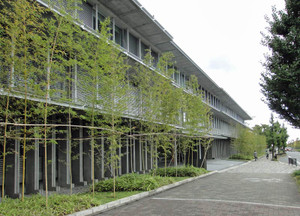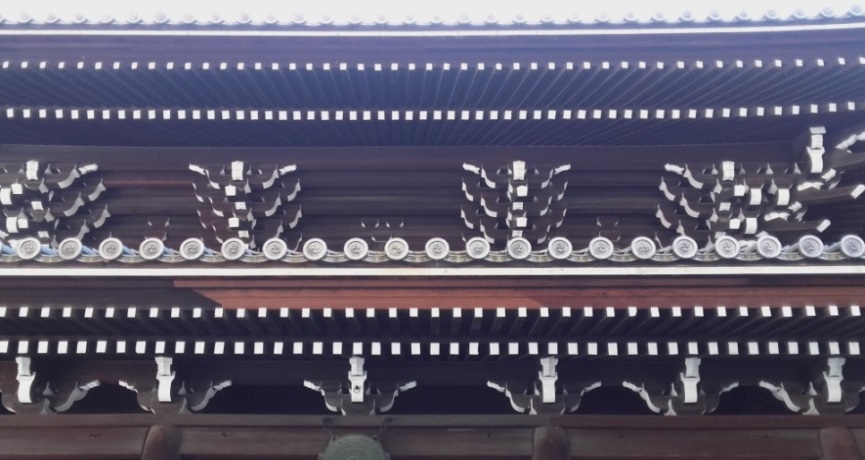African Studies in Kyoto – report of a visiting fellow
by ASCL senior researcher Jan Abbink.

The Inamori building, home of the ASAFAS and the Division of
African Area Studies, Kyoto University.
Kyoto University has the largest and probably best African Studies Center in Japan. The ‘Division of African Area Studies’ (DAAS) is part of the large Asian and African Area Studies graduate school (ASAFAS), where dozens of PhD students follow a 5-year program for the PhD. Yes, five years, because they have serious course work and also have to learn the field language of the area where they are going to work – so, e.g., for East Africa that’s Swahili, for (parts of) West Africa Fulani or Wolof, for Ethiopia Amharic or Oromo. ASAFAS is a large and dynamic school and it was quite an experience to spend four months there on a visiting fellowship from April to mid-August.
I had applied in 2014 and was invited by Prof. Masayoshi Shigeta, the dynamic director of the DAAS. My programme at the ASAFAS was not constrained – I could pursue my own work schedule, meaning some writing (of two papers), editing (e.g. the Africa Yearbook), and continuing supervision of MA and PhD students. In the course of my stay I gave four lectures on my research work in Ethiopia, attended a two day-conference of Japanese Africanists in Takashima, was also a discussant at ASAFAS graduate seminars and gave advice to graduate students. This interaction with Japanese scholars was inspiring and fruitful. My gratitude goes especially to Prof. Shigeta, Dr. Morie Kaneko and Prof. Itaru Ohta, all at AFAFAS, who were generous and fine colleagues. I also took time to meet with other good colleagues who (had) worked in Ethiopia, like Prof. E. Kurimoto of Osaka University and Prof. H. Matsuda of Kyoto Bunkyu University.
In terms of research and training, the DAAS has a heavy emphasis on ‘ecological studies’, from three angles: human, political, and historical. The staff of the ASAFAS School supervises the many students and also engages in their own research and publishing.[1] Many students at DAAS take up themes that are addressed in the work of the senior staff, amongst whom are six full professors and seven associate professors.[2] The ASAFAS, and especially the DAAS, has a strong relationship with the world of Japanese development cooperation, notably the JICA, where many graduates have found a job. The concern with ‘international development’ is still very strong among staff and students (both for policy and employment prospects), much more so than in the Netherlands.
At the ASAFAS – and perhaps in Japanese social science in general - there is a strong, focused fieldwork tradition, and the empirical research skills of both staff and students are highly developed. The consistent ecological perspective is visible throughout and has high relevance in development studies – in view of the crushing environmental problems that are emerging in Asia and Africa. Several research projects at the DAAS also have an applied side, leading to ‘valorisation’ or practical follow-up in the local field setting. The international impact of the published work by staff and students is not as big as it could be, because most of it is still done in Japanese and not in English or other global languages.
The School is highly international in orientation: many foreign visitors and guest speakers pass every year, both at the Asian and the African Studies sections of the ASAFAS and there are graduate students from Senegal, Cameroon, Ethiopia, and other countries. There are many workshops and conferences every year. The Director also strongly encourages foreign students from Europe or Asia to apply for a PhD position at the School: the programme – including the PhD courses - can be done entirely in English.

Front of the Chion-In temple gate, Kyoto.
Kyoto is the old capital of Japan (until 1868) and is a charming, very pleasant city: elegant, vibrant, keeping a nice continuity between tradition and modernity. It has many high-tech and other advanced industrial enterprises, but also maintains the old and solid artisanal tradition, producing probably the most refined material culture and artwork of Japan. The urban landscape, with its stunning temples, (Zen) gardens, parks, museums, artistic workshops – and interesting bars, entertainment & great shopping malls, is captivating. Tourists are numerous but not dominantly present in this vast city and therefore not ‘a nuisance’.
One problem of life in Kyoto for visitors is the lack of Japanese language skills. To fully appreciate academic and social and cultural life, one really needs to know Japanese. For me, although living there beyond the span of a tourist visit, that was difficult in only four months. Still: Kyoto, doomo ari-ngato gozaj mas.
[1] The Centre also publishes the scholarly journal African Study Monographs (online available: http://www.africa.kyoto-u.ac.jp/asm/index.html).
[2] See the website: http://jambo.africa.kyoto-u.ac.jp/africa_division/en/.

